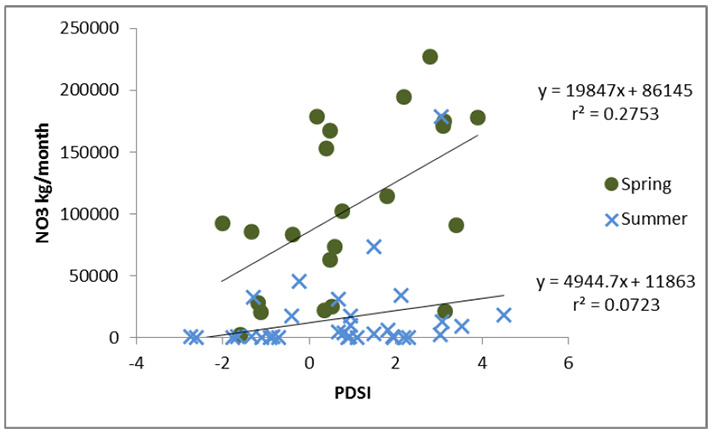
Ecological Archives E096-041-A1
Nicole M. Hayes, Michael J. Vanni, Martin J. Horgan, and William H. Renwick. 2015. Climate and land use interactively affect lake phytoplankton nutrient limitation status. Ecology 96:392–402. http://dx.doi.org/10.1890/13-1840.1
Appendix A. More detailed information about the cyanobacteria found in the reservoirs and additional figures with phytoplankton community and nutrient trends in the lake with the agricultural watershed.
Table A1. Taxa of cyanobacteria identified during enumeration. Cyanobacteria were designated as potentially nitrogen fixing or not based on "Freshwater Algae of North America" (Wehr, JD, RG Sheath, RP Kociolek, and JH Thorp, 2002). Identification as a potential toxin producer based on "Cyanobacterial toxins of drinking water supplies: cylindrospermopsins and microcystins" (Falconer, IR, 2005). Genera are labeled as potentially toxin producing if they contain species shown to produce toxin. However, actual toxin production is a function of many variables including; with in species genotype, species, and within lake physical, chemical, and biological variables, and presence of potentially toxin producing genera does not guarantee that toxins will be present.
Cyanobacteria family |
Cyanobacteria genera |
Potentially N-fixing |
Potentially Toxin Producing |
Chroococcaceae |
Chroococcus |
No |
No |
Chroococcaceae |
Dactylococcopsis |
No |
No |
|
|
|
|
Merismopediaceae |
Aphanocapsa |
No |
No |
Merismopediaceae |
Merismopedia |
No |
No |
|
|
|
|
Microcystaceae |
Microcystis |
No |
Yes |
|
|
|
|
Nostocaceae |
Anabaena |
Yes |
Yes |
Nostocaceae |
Anabaenopsis |
Yes |
No |
Nostocaceae |
Cylindrospermopsis |
Yes |
Yes |
Nostocaceae |
Raphidiopsis |
Yes |
Yes |
|
|
|
|
Oscillatoriaceae |
Lyngbya |
No |
Yes |
|
|
|
|
Phormidiaceae |
Planktothrix (Oscillatoria) |
No |
Yes |
|
|
|
|
Pseudoanabaenaceae |
Pseudoanabaena |
No |
No |
Pseudoanabaenaceae |
Planktolyngbya |
No |
No |
Fig. A1. Monthly nitrate loading (kg NO3-N/month) into Acton Lake from 2000 through 2007.
Fig. A2. Phytoplankton community composition for the lake with the agricultural lake (Acton) during the stratified periods of 2000 through 2005.
Fig. A3. Shannon-Weiner diversity index of the phytoplankton community in 2006, 2007, and the average diversity index for 2000–2005 for the intensively studied lake in the agricultural watershed.
Fig. A4. Dissolved inorganic N (DIN, i.e., NH4-N plus NO3-N; mg/L) and soluble reactive P (SRP; µg/L) concentrations from the (euphotic zone) during the stratified period from 1998 through 2010 in the intensively studied lake with an agricultural watershed.
Literature cited
Falconer, I. R. 2005. Cyanobacterial toxins of drinking water supplies: cylindrospermopsins and microcystins. First edition. CRC Press, Boca Raton, Florida, USA.
Wehr, J. D., and R. G. Sheath. 2002. Freshwater algae of North America: ecology and classification. First edition. Academic Press, Massachusetts, USA.